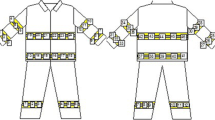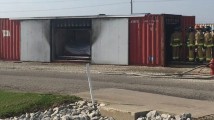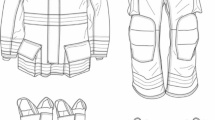Abstract
Structural turnout gear is essential for the safety of firefighters. The station wear, or clothing worn underneath the structural turnout suit, contributes to the thermal protection and performance of the overall ensemble. Depending on the fiber content and material fabrication, base layer garments may increase the risk of potential burn injuries. The purpose of this research was to evaluate National Fire Protection Association (NFPA) 1975 certified, certified flame resistant, and non-certified station wear garments in relation to firefighter burn injuries while worn under a NFPA 1971 structural firefighting ensemble. An information-gathering questionnaire was distributed nationwide with over 1800 active-duty United States firefighting personnel responding to questions regarding the selection and use of their station wear. Responses concerning the thermoplastic nature of base layer materials, the design and configuration of how base layers are worn, and the overall satisfaction with the performance of certified versus non-certified station wear were gathered. Questionnaire responses determined 80% of participants were aware of the overall risk of wearing non-certified base layer garments (i.e. synthetics that will melt or drip); however, 45% of career firefighters indicated they were not required to wear certified or flame resistant station wear. Regional analysis of the responses was performed. Findings of this research will educate the fire service and inform NFPA standards committees. Further, this study supports the need for future research to develop station wear garments with improved burn injury protection, thermal comfort, and ergonomic mobility.














Similar content being viewed by others
References
Evarts B, Molis J (2018) United States firefighter injuries 2017. Quincy, MA
Fennessy B, Saner M (2017) Protecting those who protect. Fire Rescue Magazine. https://www.firerescuemagazine.com/articles/print/volume-12/issue-6/departments/toolsnewstechniques/protecting-those-who-protect.html. Accessed 12 Feb 2019
National Fire Protection Association (2018) NFPA 1975 standard on emergency services work apparel, 2019th edn. National Fire Protection Association, Quincy, MA
National Fire Protection Association (2017) NFPA 1971 standard on protective ensembles for structural fire fighting and proximity fire fighting, 2018th edn. National Fire Protection Association, Quincy, MA
Young R (2010) Understanding turnout gear. Fire Apparatus Magazine. https://perma.cc/2EF3-M3J3. Accessed 11 July 2014
Globe (2017) Selecting your gear. http://globeturnoutgear.com/selecting-your-gear/understanding-standards. Accessed 12 Feb 2019
Fantus RJ, Rivera EA (2015) A hot mess: clothing-related burn injuries. Bull Am Coll Surg. http://bulletin.facs.org/2015/08/a-hot-mess-clothing-related-burn-injuries/. Accessed 12 Feb 2019
(2014) What to wear under turnouts. Fire Chief Magazine. https://www.firechief.com/2014/03/03/wear-turnouts/. Accessed 12 Feb 2019
National Institute of Standards and Technology (2018) Fire dynamics. Engineering Laboratory; Fire Research Division. https://www.nist.gov/el/fire-research-division-73300/firegov-fire-service/fire-dynamics. Accessed 12 Feb 2019
Krasny JF, Sello SB (1986) Fibers and textiles, fire protection handbook, 16th edn. National Fire Protection Association, Quincy, MA
Fang JB, Breese JN (1980) Fire development in residential basement rooms. National Bureau of Standards (NIST), Gaithersburg, MD
Kadolph SJ, Marcketti SB (2017) Textiles, 12th edn. Pearson, New York, NY
Stull JO, Stull GG (2014) Firefighter station wear: what certification means. Fire Rescue 1
Varner BH (2008) Selecting a station/work uniform. Fire Rescue
McQuerry M, Riedy R, Garringer B (2018) Evaluation of the performance of station wear worn under a NFPA 1971 structural fire fighter protective ensemble. Quincy, MA
Cui Z, Zhang W (2009) Study of the effect of material assembly on the moisture and thermal protective performance of firefighter clothing. Fibres Text East Eur 17(6):80–83
McQuerry M, Klausing S, Cotterill D, Easter E (2014) A post-use evaluation of turnout gear using NFPA 1971 standard on protective ensembles for structural fire fighting and NFPA 1851 on selection, care and maintenance. Fire Technol 51(5):1149–1166
Fu M, Weng W, Yuan H (2013) Effects of multiple air gaps on the thermal performance of firefighter protective clothing under low-level heat exposure. Text Res J 84(9):968–978
Jin L, Cao ML, Yu W, Hu JY, Yoon KJ, Park PK, Li Y (2018) New approaches to evaluate the performance of firefighter protective clothing materials. Fire Technol 54(5):1283–1307
Zhang H, Song G, Gu Y, Ren H, Cao J (2018) Effect of moisture content on thermal protective performance of fabric assemblies by a stored energy approach under flash exposure. Text Res J 88(16):1847–1861
Song G, Paskaluk S, Sati R, Crown EM, Doug Dale J, Ackerman M (2011) Thermal protective performance of protective clothing used for low radiant heat protection. Text Res J 81(3):311–323
Mandal S, Camenzind M, Annaheim S, Rossi RM (2017) Evaluation of heat and flame protective performance of clothing using manikins. Elsevier, Cambridge, MA
Schmid M, Annaheim S, Martin C, Rossi RM (2016) Determination of critical heat transfer for the prediction of materials damages during a flame engulfment test. Fire Mater 40:1036–1046
Crown EM, Ackerman MY, Dale JD, Rigakis KB (1993) Thermal protective performance and instrumented mannequin evaluation of multi-layer garment systems. In: Performance of protective clothing, USA, vol 5
Smith DL (2013) Tools and technologies: base layer clothing: part of the protective ensemble. Firehouse. http://www.firehouse.com/article/11150042/tools-technologies-base-layer-clothing-part-of-the-protective-ensemble
Smith DL, Arena L, Deblois JP, Haller JM, Hultquist EM, Lefferts WK, Russell T, Wu A, Fehling PC (2013) Effect of base layer materials on physiological and perceptual responses to exercise in personal protective equipment. Appl Ergon 45(3):428–436
Smith DL, Haller JM, Hultquist EM, Lefferts WK, Fehling PC (2013) Effect of clothing layers in combination with fire fighting personal protective clothing on physiological and perceptual responses to intermittent work and on materials performance test results. J Occup Environ Hyg 10(5):259–269
Smith DL, Haller JM, Hultquist EM, Lefferts WK, Fehling PC (2013) The station uniform shirt. Firehouse, pp 74–79
Yoo S, Barker RL (2005) Comfort properties of heat-resistant protective workwear in varying conditions of physical activity and environment. Part I: thermophysical and sensorial properties of fabrics. Text Res J 75(7):523–530
Dorton MC, Ruby BC, Dumke CL (2019) A synthetic undergarment increases physiological strain. J Wildl Fire 28(4):275–281
Dorton MC (2015) Impact of a flame resistant synthetic material base layer on heat stress factors. Thesis, Department of Health and Human Performance, The University of Montana, pp. 1–52. http://scholarworks.umt.edu/cgi/viewcontent.cgi?article=5460&context=etd
Wickwire J, Bishop PA, Green JM, Richardson MT, Lomax RG, Casaru C, Curther-Smith M, Doss B (2007) Physiological and comfort effects of commercial ‘wicking’ clothing under a bulletproof vest. Int J Ind Ergon 37(7):643–651
McLellan TM, Selkirk GA (2004) Heat stress while wearing long pants or shorts under firefighting protective clothing. Ergonomics 47(1):75–90
Kalyani MN, Jamshidi N (2009) Comparing the effect of firefighting protective clothes and usual work clothes during physical activity on heat strain. Pak J Med Sci 25(3):375–379
Markle J (2015) Melt and stick behavior of polyester fabric to porcine skin. North Carolina State University, Raleigh
Petrilli T, Ackerman M (2008) Tests of undergarments exposed to fire. Missoula, MT
Huang D, Yang H, Qi Z, Xu L, Cheng X (2012) Questionnaire on firefighters’ protective clothing in China. Fire Technol 48:255–268
Park H, Park J, Lin S, Boorady L (2014) Assessment of Firefighters’ needs for personal protective equipment. Fash Text 1(8):1–13
Spiggle S (1994) Analysis and interpretation of qualitative data in consumer research. J Consum Res 21(December):491–504
Boorady LM, Barker J, Lee Y, Lin S, Ashdown SP (2013) Exploration of firefighter turnout gear part 1: identifying male firefighter user needs. J Text Appar Technol Manag 8(1):1–13
Boorady LM, Barker J, Lin S, Lee Y, Cho E, Ashdown SP (2013) Exploration of firefighter bunker gear part 2: assessing the needs of the female firefighter. J Text Appar Technol Manag 8(2):1–12
Park H, Hahn KHY (2014) Perception of firefighters’ turnout ensemble and level of satisfaction by body movement. Int J Fash Des Technol Educ 3266(June):37–41
Karter MJ (2013) U.S. fire experience by region 2007–2011 annual average. Quincy, MA
Acknowledgements
The author would like to acknowledge the National Fire Protection Association (NFPA) Fire Protection Research Foundation (FPRF) for their support of this project, including the members of the project technical panel: Jeremy Metz, Rick Swan, Bill Haskell, Tony Petrilli, Daniel Gorham, and Christopher Farrell. A downloadable copy of the corresponding published NFPA FPRF research report can be found at: https://www.nfpa.org/News-and-Research/Data-research-and-tools/Emergency-Responders/Evaluation-of-the-Performance-of-Station-Wear.
Author information
Authors and Affiliations
Corresponding author
Additional information
Publisher's Note
Springer Nature remains neutral with regard to jurisdictional claims in published maps and institutional affiliations.
Appendix: Survey Questions
Appendix: Survey Questions
Survey Block 1: Informed Consent
Survey Block 2: Background Information
This information gathering questionnaire will allow the National Fire Protection Association to better develop standards for firefighter uniforms. Results will help evaluate the impact that both certified NFPA 1975 and non-certified station wear garments have in relation to firefighter burn and heat injury while worn under a certified NFPA 1971 garment in a system-level testing environment. The report will be useful for the fire service and NFPA 1975 and NFPA 1971 technical committees.
Survey Block 3: Demographics
- 1.
What is your age (in years)?
- 2.
What is your gender?
- 3.
Which of the following ethnic groups do you consider yourself to be a member (check all that apply)?
- 4.
Department Service Type
- 5.
Fire Service Commitment
- 6.
Years of Experience in the Fire Service
- 7.
Rank in Fire Service
- 8.
Current City, State of Service
- 9.
Number of uniformed personnel in your current department
Survey Block 4: Station Wear Selection
Familiarization with Terms: Definition of Certified versus Certified FR versus Non-Certified
- 1.
Are you familiar with NFPA 1975: Standard on Emergency Services Work Clothing Elements requirements?
- 2.
Are you aware of the risks associated with wearing non-certified base layer garments under your NFPA 1971 certified bunker gear?
- 3.
Does everyone in your department wear the same base layer/station wear under their turnout gear?
- 4.
Does your department provide you with or instruct you to wear specific station wear?
- a.
If yes, is your station wear NFPA 1975 certified (i.e. is there a certification lab on your station wear)?
- i.
If no, has your department considered or wear tested NFPA 1975 certified station wear in the past? If so, why did the department choose not to?
- i.
- a.
- 5.
Does your department require you to wear NFPA 1975 certified flame resistant station wear (please reference terms at the beginning of this section)?
- a.
If yes, please describe your station wear in detail (i.e. garment style, manufacturer, fiber content, etc.). This information can be found on the garment label.
- b.
If no, what do you wear as station wear? Be as descriptive as possible (i.e. garment style, manufacturer, fiber content, etc.).
- a.
- 6.
How did you choose the station wear that you use now?
- 7.
Please indicate the level of importance you place on each of the following factors when selecting your station wear: comfort, mobility, and safety/protection.
Survey Block 5: Station Wear Use
- 1.
Do you wear shorts or long pants under your turnout suit? Please indicate the frequency.
- 2.
If you wear shorts, what months out of the year do you where them? Check all that apply.
- 3.
Do you wear long sleeve or short sleeve shirts under your turnout suit?
- 4.
Please indicate the frequency that you wear each shirt configuration below.
- 5.
If you indicated that you wear long sleeves above, do you wear a long sleeve shirt on top of a short sleeve t-shirt?
- 6.
If you wear a short sleeve shirt, what months out of the year do you wear it? Check all that apply.
- 7.
If you wear a short sleeve shirt, what months out of the year do you wear it? Check all that apply.
- 8.
Which of the following shirt configurations do you wear the most often at the fire station?
- 9.
Which of the following shirt configurations do you wear most often underneath your turnout suit?
Survey Block 6: Station Wear Materials
- 1.
Is your station uniform certified as flame resistant according to NFPA 1975?
- 2.
What is the fiber content of the station uniform you currently wear? Please provide this information in detail (i.e. 50% cotton, 50% polyester).
- 3.
Do you prefer to wear synthetics (polyester, nylon, etc.) instead of cotton or wool station wear?
- a.
If yes, why do you prefer synthetics (i.e. comfort, feels cooler, easier to move in, etc.)
- a.
Survey Block 7: Station Wear Design
- 1.
Please indicate your level of satisfaction with your current station wear for the following factors: comfort, mobility, and safety/protection.
- 2.
What features are the most important to you in a station wear uniform? (Choose only 3) (Options: thermal protection, liquid protection, chemical/biological contaminant protection, comfort (breathability), moisture management, mobility and range of motion, design and aesthetic appeal, other/comments)
- 3.
Do you think your current station wear provides sufficient thermal protection? Why or why not?
- 4.
Do you think your current station wear provides sufficient comfort? Why or why not?
- 5.
Would you sacrifice the heat resistance (meaning no melting would occur) of your station wear in order to improve your comfort? Why or why not?
Survey Block 8: Open-Ended Questions
- 1.
If you could change the materials and/or design of your station wear, what would you change and why?
- 2.
If you choose to wear a non-certified 1975 station uniform, please explain why.
- 3.
Are you personally aware of any incidents in which wearing a synthetic station wear or base layer garment underneath a turnout suit caused burn injuries due to melting of the fabric onto the skin? If so, please describe the scenario below.
- 4.
Are there are any other comments or concerns that you have pertaining to your station wear when worn under a NFPA 1971 structural firefighting ensemble?
Rights and permissions
About this article
Cite this article
McQuerry, M. A Survey of Structural Firefighter Station Wear in the United States. Fire Technol 56, 1287–1313 (2020). https://doi.org/10.1007/s10694-019-00930-9
Received:
Accepted:
Published:
Issue Date:
DOI: https://doi.org/10.1007/s10694-019-00930-9




